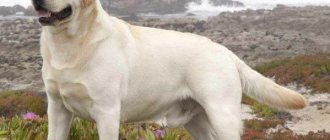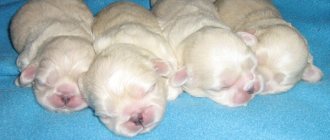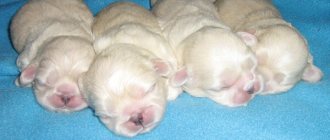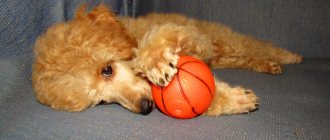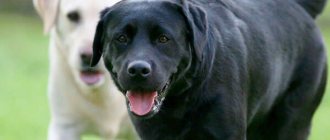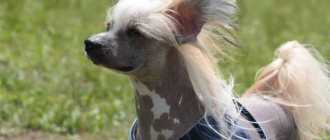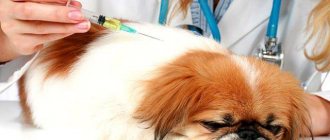One of the most loyal and kind dog breeds is the Labrador Retriever.
Dogs of this breed are distinguished by their intelligence and friendliness.
Thanks to these qualities, they are considered the best guide dogs.
Labrador gets along well with all family members: from children to the elderly.
Like all purebred dogs, Labradors should be purchased from a breeder to ensure the purity of the breed.
Photos of newborn puppies
Newborn Labrador Retriever puppies have ears and eyes initially closed; they are unable to regulate their body temperature on their own, so they must be kept in a warm room (do not keep them near a radiator or fireplace, this can harm them). Usually the mother provides the desired temperature, keeping the puppies warm.
Externally, the puppies already look like adult representatives of the breed, but they are a smaller copy of them, the muzzle is less pointed.
Puppies open their eyes at about 10 days, there may be delays up to 16 days.
At this age, thermoregulation begins to improve.
NOTE!
You should be careful, since it is during this period that the bitch’s hormonal levels change, which is why the puppy may have temporary digestive problems.
The weight of newborn puppies ranges from 400 to 550 g. Height at the withers is from 12 to 15 cm. Usually a bitch gives birth to up to 5-10 puppies.
Labrador personality
Labradors are rightfully called universal dogs. This breed has no aggression at the genetic level; Labradors are obedient, loyal and good-natured, but at the same time quite fearless: this dog is very difficult to scare.
Labrador Retriever: Walking each other.
Labrador Retriever: puppy look.
Labradors are smart and insightful, have a stable psyche, understand a person at a glance, and feel great in any environment. Therefore, they are ideal for both a large family and a single owner.
Labradors, originally intended for hunting and heavy physical activity, do not tolerate a sedentary lifestyle, so the pet needs regular walks with active games and bathing.
A born fetcher, the Labrador, with the best of intentions, will try to bring everything to its owner, so it is necessary to raise a dog and teach it to the “fetch” command from early childhood.
A Labrador Retriever puppy is taught to hunt.
The lifespan of a Labrador is between 13 and 15 years.
The dog breed, which is incredibly popular in all countries, is considered universal, as it has many talents. The Labrador Retriever dog is an indispensable companion of rescuers; he is among the first to arrive at the scene of disasters to look for people under the rubble. There are many Labradors serving in the police, airports and railway stations, performing search functions. The natural friendliness of this breed allows them to be used as guide dogs, but initially these dogs were used as game hunters.
The Labrador Retriever is a fairly ancient breed of dog that lived on the island of Newfoundland. Smart, large dogs loved water, could dive and swam well, often rescuing children and careless adults who had fallen into the sea. Cheerful and kind dogs willingly played with children and learned quickly. In addition, Labradors were used by local residents as hunting dogs, who brought game from hard-to-reach places, thickets or from water.
The sailors who arrived on the island were surprised by the abilities of the local dogs and willingly purchased them for service at sea. Sea travel was not at all depressing for the dexterous dogs, who had waterproof fur, because ice flakes did not stick to it, and a specially shaped tail, with which they maneuvered through the waves. Labradors (translated from Portuguese as a worker) brought caught fish from the water and tackle that had fallen into the sea or cables and other equipment washed away by the waves.
Dogs came to Britain at the beginning of the nineteenth century. Local residents were happy to acquire smart and friendly dogs that got along with animals, loved children and did not attack poultry. The character of Labradors did not have the aggression and malice inherent in terriers, so they quickly became popular not only among sailors, but also among farmers and townspeople.
It took the breed less than a hundred years to be recognized by the English Kennel Club. In 1903, it received official recognition and the Labrador Retriever standard was approved. According to him, only black representatives of the breed were allowed for breeding, although initially the breed had fawn, chocolate and black colors. Much later, decades later, the standard was slightly changed, and all three colors were officially recognized.
England is considered not only the ancestor of the Labrador breed, but also became the first country where, in the seventies, there was a clear division into working and show dogs. Field dogs had a drier type of constitution; they had light bones and an elongated muzzle. Exhibition or show dogs were rawer, heavier, with large heads and shortened muzzles.
Currently, the division into show and working Labradors is still visible, but the trend towards heavier bones is gradually fading away. In the rings, dogs with a strong build with a proportional head and a hard coat inherent to the breed are increasingly winning.
Development by day in the first month
Every day after the puppy is born, there is an increase in weight. In the first month, approximately 100-150 g per day.
From days 1 to 14, newborn puppies can only crawl and suckle at their mother's breast, gradually their sense of smell develops, and they independently try to find their mother.
It is necessary to closely monitor the puppies' temperature and avoid hypothermia when the body temperature drops to 34 degrees Celsius. If the puppies have a low temperature, they should be warmed up immediately on your chest. This method is the most effective and correct.
From 15 to 30 days, puppies open their eyes, a noticeable reaction to light, sounds, and nearby movement. At this time, animals begin to go to the toilet on their own and their teeth are cut. Dogs are becoming more and more active, starting to crawl and even run.
From days 21 to 30, the puppy begins to recognize the people around him. During this period, you need to especially carefully protect the puppy’s safety: it is forbidden to make loud noises, as this can negatively affect the pet’s condition. During this period, small Labradors learn the behavioral patterns of dogs.
Groundbait is introduced, which can cause small Labradors to experience diarrhea; this is a normal phenomenon, as they find it difficult to tolerate changes in diet. This should not be a cause for concern as long as the color and smell of the discharge does not change.
IMPORTANT!
If there are changes in the smell and color of the discharge, treatment must be started immediately. For this purpose, special medications are suitable to help normalize the functioning of the gastrointestinal tract.
A little about the bite
After the milk teeth fall out, the four-legged pet grows 42 molars. Their position affects abrasion and wearability. With proper bite, a healthy dentition is preserved almost until old age.
Types of bites
The closure of the upper and lower jaws varies slightly between breeds. In such cases, the deviation from the norm is explained by genetics and is not a pathology.
There are 4 types of bite:
- Scissor-shaped
. The anatomical norm is when the upper incisors neatly cover the lower ones. When closing, the jaws do not touch, and a small gap of 3 mm is formed between them.
- Snack
. The lower jaw extends beyond the upper jaw, exposing the teeth located on it. This variety is typical for pugs, bulldogs and boxers.
- Pincer-shaped
. The jaws close in a straight line, so the incisors quickly wear down and become unusable.
- Underbite
. The gap formed during closure exceeds 3 mm. This violation is typical for a too shortened lower or elongated upper jaw. Due to the tight compression, the fangs wear down and break.
The last type is the most dangerous. Unlike a pincer bite, when overbiting, not only the incisors are erased, but the entire dentition.
Correct bite formula
With a correct bite, the animal should have exactly 42 teeth: 22 on the lower jaw and 20 on the upper. These include:
- 12 incisors;
- 4 fangs;
- 16 premolars;
- 10 molars.
Most breeds have a scissor bite. Misaligned jaws or a tongue protruding from a closed mouth is considered a pathology.
Growth from 1 to 12 months
The first year of a Labrador’s life deserves special attention:
| Age | Weight | Height | Description |
| 1 month | 3.4-4.8 kg | 23-32.5 | A wet and cold nose, an elastic belly, a uniform coat color, a tail similar to that of an otter. The one-month-old puppy is playful and active. |
| 2 months | 7-8 kg | 30-32.5 | At this age, the baby feels comfortable away from his mother and other puppies. Baby teeth begin to develop. |
| 3 months | 12-14 kg | 39.5-42 | It grows actively and becomes restless. From the moment of birth, growth triples. |
| 4 months | 17-19 kg | 44-46 | An awkward body, the so-called teenage period. Teeth begin to cut. The differences between females and males are visible. |
| 5 months | 21-22 kg | 48-51 | The paws lengthen, the puppy becomes stronger. Teeth change. In male dogs, the testicles droop. |
| 6 months | 24-26 kg | 50-55 | The puppy must know all commands and obey easily. Getting used to using the toilet outside the home. |
| 7 months | 26-28 kg | 52-56 | Puberty is reached. All the teeth have already changed. |
| 8 months | 28-30 kg | 54-57 | Bitches are ready for heat and can begin to mark their territory. |
| 9 months | 30-32 kg | 54-58 | The last stage of growing up occurs. The weight reaches its typical level (for females 27 kg, for males 30 kg). |
| 10 months | 32-34 kg | 54-58 | The puppy looks like an adult, its physique is completely formed. |
| 11 months | 34-36 kg | 54-60 | The dog stops growing. |
| 12 months | 30-38 kg | 54-61 | Puppies finally take on the appearance of adult dogs. Powerful and strong paws, short tail, thickened at the base. |
The growth of Labrador puppies depends on genetics, but full maturity is achieved at the age of 12 months.
Basic care rules
When caring for a Labrador puppy, you must follow several rules:
- Monitor his body temperature (several degrees above the environment, but not less than 35 degrees).
- Monitor the puppy's weight and feeding (every hour and a half, it is best if the mother is constantly with the puppies).
- If you are underweight, you should intervene and start feeding them or check the condition of the gastrointestinal tract and start treatment in a timely manner.
- When teeth begin to erupt, give him the opportunity to chew on something.
- Monitor your puppy's stool (color, smell, consistency).
- Training (starts at 2-3 months).
- Hair care (constant combing, keeping clean).
- Timely vaccination (puppies are not protected from all diseases, so vaccination is one of the most important stages; this should be done at the age of 16 weeks).
What can you chew to relieve itchy gums?
During the period of teeth change, most owners, through their own carelessness, lose valuable things - shoes, headphones, notebooks and even phones. Furniture, floor coverings, door jambs, etc. are often damaged. How to prevent a “catastrophe”.
What can you give your puppy to chew to relieve discomfort:
- Durable toys - so that the baby does not get bored with the same objects, they can be changed every 2-3 days.
- Teethers are durable, specially shaped toys. The advantage of teethers is that they are safe; even if the puppy bites off a piece of the toy and swallows it, nothing will happen.
- Chewable treats (bones, sticks).
- Large articular bones (moslaks) with meat, spongy bones, raw and boiled cartilage.
- Raw vegetables and fruits.
- Wood, dry, preferably from fruit trees.
The best option to interest the puppy and teach him to chew only permitted objects is special treats and toys.
Bones are a good option if the puppy is in plain sight, but needs something to keep him occupied. Vegetables and fruits are the most useful toy. The puppy receives vitamins, coarse fibers and is accustomed to healthy food.
Why does my puppy urinate frequently?
Newborn Labrador puppies cannot defecate on their own, so their mother licks them to stimulate the discharge.
This reflex can remain with the puppy even as he begins to mature. This is due to the fact that he does not yet have full control of his bladder.
This should go away over time, but if the owners notice unusual behavior in the puppy, this may indicate a disorder. Mostly, frequent urination can be a result of fear or stress.
The only thing that can be done in such a situation, when the puppy urinates frequently, is to contact a veterinarian, who will identify the cause of the behavior and prescribe medications, or send the pet to a canine psychologist.
How to toilet train?
to toilet train your puppy as soon as he begins to move around and defecate on his own. Training takes place in 2 stages: home and street. First you need to teach your dog to relieve himself on a diaper or oilcloth.
CAREFULLY!
It is dangerous for an unvaccinated dog to walk outside the home, as the risk of disease increases significantly.
At first, you need to carefully monitor your pet’s behavior. Typically, bowel movement occurs immediately after sleep or immediately after feeding. As soon as the puppy begins to walk restlessly and sniff, the owners should help him do his business in the right place. This should be a signal of readiness.
Under no circumstances should you scream or hit your pet for urinating in the wrong place. The puppy is still small and just learning, and shouting and violence can harm him both physically and psychologically. The owner should be a protector and friend, not a tyrant.
You should definitely praise your pet for doing things where necessary and even reward him with a treat.
Don’t be surprised if the puppy manages to leave a puddle overnight. He simply does not know how to endure; this skill will appear only with age.
The second stage is not much different from the first. All the same machinations must be carried out on the street. There is no need to be shy about praising your dog and showing sincere joy when it successfully goes to the toilet; this will only be beneficial.
When walking a dog (for the purpose of toilet training on the street), you need to try to protect it from distractions: people, cars, other animals.
Master's Code
A loyal friend, companion, assistant - that's all he is, a Labrador; caring for and keeping a representative of the breed at home can seem quite complicated. This is an active dog that needs to run around and splash out its energy. In addition, due to its considerable size, it consumes quite a lot of feed.
Labrador is an excellent companion and faithful friend for many years
For your information! Those owners who decide to stick to natural food will have to cook especially for the dog, and in large portions.
Before you make the final decision to become a Labrador Retriever owner, you should familiarize yourself with the following owner code:
There are no bad dogs. There are unscrupulous and irresponsible owners; The standard life expectancy of dogs is 12-18 years. All this time he will need to be taken care of, walked every day, regardless of the weather and health; an animal is not a toy that you can get rid of if you decide you’re tired of it
This is a living creature with its own character and habits; it's important to be consistent. The cute antics of a puppy who loves to affectionately bite his owner’s legs will no longer be so touching as he grows up.
Therefore, from early childhood, all prohibitions are practiced clearly. If you can’t, then you can’t forever; training and training should be carried out according to the principle from simple to complex. A “carrot and stick” policy without physical violence and aggression is the choice of a responsible owner. “Whip” in this case is a stern tone, a demonstration of displeasure; The dog's nutrition is the responsibility of the owner. A dog is not a pig, waste from the human table is not suitable. They either prepare it separately or buy ready-made industrial feed; The veterinarian is a specialist whom you will have to get to know. Preventive examinations should become a good habit. It is better to prevent any disease than to treat it.
These are the main points that a Labrador owner should consider.
The Labrador will become a true friend to its owner, but needs proper training
Nutrition in the first 3 months
The difficulty in keeping these pets in the first months lies not only in toilet training, but also in proper feeding. The digestive system of this breed is very delicate and reacts sharply to changes in diet. Therefore, this issue must be approached with all seriousness.
For the first month, the puppy feeds on mother's milk, but if there is a deficiency of calories and nutrients in it, the puppy may lose weight. In this case, you need to help him with additional nutrition.
At the age of up to 3 months, you need to pay special attention to the frequency and timing of feeding small puppies. The interval between meals is at least 1.5 hours, duration – no more than 20 minutes. You should not force feed the animal, but you should not allow it to be distracted while eating. If feeding turns into play and pampering, you need to stop it immediately.
NOTE!
You should always make sure there is water in your dog's bowl. It should always be clean and fresh, and the pet should have unlimited access to it. If you refuse to drink or feed, you should immediately consult a doctor. This may indicate serious illness.
It is best to start feeding with liquid cereals, since the pet is not able to chew food fully (teeth simply have not developed). Gradually, you can get used to dry food, which will be soaked in kefir or yogurt before feeding. To help the growing body cope with food, it is recommended to give your puppy prebiotics. This should also be done if you have loose stools.
Outdoor content
Labradors are a domestic breed, and it is highly undesirable for them to constantly live outside.
This especially applies to puppies, who are sociable and affectionate creatures. Labradors living in a private home are the luckiest of all, because they are provided not only with cozy housing, but also with an excellent playground. As in the apartment, an enclosure for the dog is being built in the yard, in which the place of the bed should be taken by a full-fledged kennel on an elevated island. A Labrador's kennel must be large and strong so that the dog can fit in it completely and comfortably. Standard kennel sizes for this breed are 110 cm in length, 90 cm in width and 80 cm in height.
In addition to the booth, there should be a feeding area with bowls filled with fresh water and food, a canopy that creates shade, and toys. When letting the puppy out of the enclosure, make sure that he does not come across trash in the yard or food waste. In addition, Labradors are capable of digging, so the fence and walls of the enclosure must be strong.
How to feed a grown pet?
With each month, puppies need to reduce the number of feedings per day and increase portions.
First, you need to feed the dog 5-7 times a day and give it 300-350 grams of food per day. That is, about 50 grams per meal. At 3 months, the portion increases to 400-450 grams per day, and the number of feedings decreases to 4-5 times a day.
Sample menu for the week:
- Liquid oatmeal – 2 times a day. One boiled egg. Kefir.
- Liquid buckwheat with finely chopped boiled meat, yogurt, grated cabbage.
- Rice porridge in water, with the addition of a few drops of vegetable oil, fish, grated pumpkin.
- Buckwheat (can be made thicker), medium-chopped meat, grated potatoes (raw).
- Cottage cheese, oatmeal, pumpkin (grated), fish.
- Coarsely chopped meat, carrots (grated), raw yolk, rice porridge.
- Fresh herbs (added to the porridge), porridge at your discretion, meat, grated zucchini.
If necessary, you can include vitamins prescribed by a veterinarian and various nutritional supplements in the menu. You can also use homemade supplements.
Which dry food to choose?
Several criteria for choosing the right dry food:
- the most important thing is that the puppy must like it;
- the pet should not be allergic to it or intolerant to the products present in the composition;
- availability;
- the price must be acceptable to the owner;
- quality.
It is best to avoid buying the cheapest food, as it may be of poor quality. For puppies, it is better to choose special food designed for early feeding. Royal Canin and NaturVet are considered popular dry foods.
Vaccination schedule and which ones should be done?
The table below shows which vaccinations are required for a Labrador by age:
| Name of the disease | Primary vaccination | Revaccination | Subsequent vaccinations | |
| First vaccination | Second vaccination | |||
| Rabies | 4 months | – | 12 months | Every year |
| Plague | 2-2.5 months | In 3-4 weeks | 12 months | Every year |
| Infectious hepatitis | 2-2.5 months | In 3-4 weeks | 12 months | Every year |
| Parvovirus enteritis | 2-2.5 months | In 3-4 weeks | 12 months | Every year |
| Canine parainfluenza | 2-2.5 months | In 3-4 weeks | 12 months | Every year |
| Leptospirosis | 2-2.5 months | In 3-4 weeks | 12 months | Every year |
| Trichophytosis | 1 month – six months | In 1.5-2 weeks | 12 months | Every year |
| Microsporia | 1 month – six months | In 1.5-2 weeks | 12 months | Every year |
How to bathe properly?
The next aspect, which is no less important when caring for a Labrador, is bathing. You should not bathe your pet often; do it only when absolutely necessary. Since the Labrador's coat repels water, it will be quite difficult to get your dog wet. You can bathe with or without shampoo.
Do not allow water or shampoo to get into your ears, eyes or mouth.
This breed loves to splash in the water, but they are not always able to endure the washing procedure.
Three colors of Labrador
According to the standard, Labradors come in three colors:
- Black;
- Chocolate;
- Fawn.
Black coloring is considered traditional and is complemented by brown or hazel eyes and dark earlobes. A dog with such fur shines and shimmers in the sun. The blackness can be diluted with a white spot on the chest or tan marks.
The “boom” of dogs with brown fur has not yet passed, and more and more people want to have such a spectacular pet.
The combination of chocolate color with hazel or yellow eyes is also interesting. However, “rich” chocolate must be properly cared for: do not keep dogs in the sun for long and feed it with special vitamins.
Labradors with fawn coats come with golden, light cream, red tint or brown pigmentation.
Cleaning teeth, ears and trimming nails
First, you need to carefully examine your ears and teeth for inflammation or infections.
To clean your ears, you can use cotton wool, gauze, cotton pads, cotton swabs or special wipes.
You can brush your teeth yourself by wrapping your finger in gauze or a bandage, or with a special brush. You can also use teeth cleaning products purchased at a pet store.
As for trimming claws, if the owner does not have sufficient experience, it is better to contact a specialist. In any case, you need to buy special tweezers for cutting.
Nothing terrible happens
When talking about mating, it is definitely worth explaining such a physiological phenomenon as a “lock”. Dogs enter this state in the final stage. Outwardly, everything looks quite strange. They stand with their backs pressed against each other. For ignorant people, it may seem that something terrible has happened - the poor animals cannot disentangle themselves and are stuck to each other. In fact, everything is understandable.
The fact is that during intercourse, the bulb of the genital organ (head) of a male dog increases significantly in size. At the same time, it is tightly clamped by the muscles of the bitch’s vagina. This is how a “lock” or state of gluing is obtained. The male can free himself only after the head reaches its normal size and the vaginal muscles relax. This takes 10-15 minutes, and sometimes more. This is how nature took care of creating conditions for fertilization during mating.
At this time, the dogs should not be disturbed; they should be given the opportunity to complete the process.
By the way, mating is also observed in other dog-like animals - wolves, hyenas, jackals.
How to care for wool?
The coat of Labrador puppies is smooth and short, so it is not very difficult to maintain. It only needs to be combed 2-3 times a week with a special brush.
If your puppy has dandruff, you should contact your veterinarian. Many people advise increasing the humidity in the house or moisturizing the pet’s skin directly with special lotions. You can also try changing the food.
Frequent bathing can also lead to dandruff, however, washing with a special shampoo will not hurt.
Hygiene
There is an opinion that large breed dogs have a characteristic odor, but this only happens when the owner does not pay enough attention to the pet’s hygiene. In order for a Labrador living in an apartment to be well-groomed, you need to regularly comb the pet’s fur, bathe it when it gets dirty, trim its nails and clean its ears.
If your Labrador exhibits lethargy, upset bowel movements, vomiting, skin rash, inflammation and suppuration of the eyes (ears) and other abnormalities, you should immediately show the dog to the veterinarian!
Popular articles Cats: description of all breeds
How to train and what commands to teach?
Training a puppy involves teaching basic commands:
- place;
- to me;
- ugh;
- sit;
- lie;
- give me your paw;
- voice;
- stand;
- fetch;
- front;
- near.
The dog learns each command only through encouragement; under no circumstances should you use physical force or shout. You should start with a nickname and leash training.
Popular nicknames
The question of what to name a puppy should be taken seriously. The name should be simple and suitable for the pet.
The following nicknames are suitable for male Labrador puppies:
- Tyson;
- Jack;
- Bonya;
- Caesar;
- Rex;
- Hachiko;
- Graph;
- Baby;
- Ricci.
The girl can be called by the following names:
- Jaycee;
- Alma;
- Lucky;
- Bagheera;
- Gerda;
- Jesse;
- Nika;
- Eve.
How to choose your future pet?
Choosing a Labrador puppy depends on personal preference. You can choose between a boy and a girl, color and character. It is necessary to observe the behavior of the puppy and its parents, make sure that the breed is pure and has a passport. You need to make sure that neither of the parents has or is sick with anything, as this could be passed on to the puppy.
IMPORTANT!
The most important thing when choosing a puppy is the realization that you are acquiring a new family member who needs affection and care. You will need to monitor his health, hygiene and mood, as well as educate him. In the future he will become the most devoted friend and protector.
